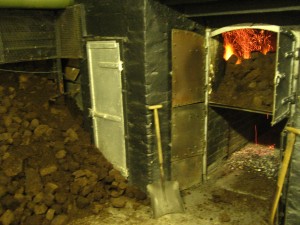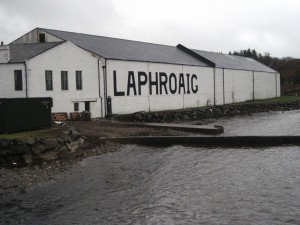The first bottle of Islay single malt I ever purchased was the Laphroaig 10-year-old. When I first started exploring single malts, I heard mysterious rumblings from whisky people about this island dram that was a love-it or hate-it pour. There were single malts you enjoyed and there was Laphroaig. Even the name invited a special challenge. Laap-Hro…egg??? (actually pronounced La-froyg). I went to a whisky shop in San Francisco to make the purchase and the owner raised an eyebrow when I said I’d never even sampled it. He put it in the bag with a “I hope you know what you’re in for” kind of look on his face.
When I opened the bottle for the first time, I recoiled at the medicinal aroma. It smelled like something you’d soak bandages in before putting them on wounds (later I would find out that this aroma benefited Laphroaig during the US Prohibition, as it was marketed and sold as medicine). The nose betrayed an almost sickly sweet mixture of smoke, seaweed, and alcohol. I reluctantly sipped this ill advised purchase and screwed my face in anticipation of the horrible taste. I sipped it again. Hmmm. Interesting. Another sip. I was starting to have the feeling you get when you peel off a scab: it hurts, but in some strange way it also feels good. I took another sip. And another. I didn’t feel ill, I felt excited.
Since then, my whisky collection has never been without a Laphroaig.
The excitement from my first bottle of Laphroaig (www.laphroaig.com) carried over to my first recent visit to the distillery. Just as I had to fight the elements of Laphroaig’s malt in order to enjoy my first taste, so too did I have to fight the elements to get to the distillery for my first visit. I was there on a miserable day of heavy wind, cold rain, heavy rain and cold wind (on Islay it’s possible for the wind and rain to each do two things at once, just to make outdoor excursions all the more challenging).
Laphroaig has enjoyed a 50 percent growth in the U.S. market in the past year, which explains why the only other person there on this wicked weather day was a fellow from New York. The distillery is a mixture of old and new. They still do their own floor maltings for a percentage of their whisky. However, with an annual production of more than two million litres, their equipment is modern through and through.
The thing that grabs you most about Laphroaig is the location, wedged on a developed piece of land bordered by bogs and woods on one side and the raging sea on the other side. In fact, once you see the setting, especially under the conditions I did, you understand why Laphroaig has an otherworldly taste: it comes from an otherworldly place.
Distillery Manager John Campbell, who joined the distillery in 1994, says the magic of Laphroaig is that the taste does take your imagination to a place as wild and untamed as Laphroaig. The third-generation whisky maker thinks that with the stresses and speed of modern life, people enjoy the mental picture of escape Laphroaig provides. The image, along with the layers of flavor in the spirit, is what drives the continued growth of the product.
The distillery has nearly 350,000 “Friends of Laphroaig” — fans from around the world who are wild about the whisky. They flock to the distillery throughout the year, and when not visiting in person, enjoy several online opportunities to see Laphroaig in action, including partaking in a “Laphroaig Live” Web event. As I talk with John, I hear the sea crashing against the rocks of Laphroaig’s oceanside doorstep. I realize that from these shores a whisky was launched nearly 200-years-ago that still makes huge waves around the world.
I’m sitting in the Port Charlotte Hotel pub as I write this Laphroaig musing. The pub was named the Whisky Pub of the Year in the Good Pub Guide 2009 (http://www.thegoodpubguide.co.uk/pub/view/Port-Charlotte-Hotel-PA48-7TU) and has a fantastic selection of Islay malts. Laphroaig is well-represented on the list with nearly a dozen offerings. For my money, the Quarter Cask and the Cask Strength are fantastic. The 15-year-old, which is being phased out in favor of an 18-year-old, is also a great dram.
I always tell people that the 10-year-old is the perfect example that age doesn’t necessarily dictate how good a whisky can be. When it’s ready, it’s ready. I highly recommed you give Laphroaig a try and add a drop of water to open up the sweetness. At first blush, you may find it a bit challenging, but give it a chance. Who knows? Maybe you’ll end up finding a new friend.



Well put Rob. I Agree wholeheartedly, try it. I absolutely love the 10 yo. Can’t wait to visit this summer and see it in person…however I hope to get better weather.
Rob,
Laphroig has been one of my favorites for a long time. The 15 years old was a bottle I would treat myself to when I had reached certain goals in life. I had never tried the quarter cask till last year and it immediately became one of my favorites. Thank you for the introduction. As a whisky enthusiast I have always tried to match whiskies with food. My personal favorite was chocolate with a speyside until my recent trip to New York where I visited Gramercy Tavern. There I experienced what could only be described as taste bud heaven, matching a quarter cask with a smoked lobster. Thanks again for continuing to include us in your thoughts and experiences.
Regards, Mark
Great point Mark. I find many of the peatier whiskies go really well with seafood, but especially Laphroaig and Lagavulin, perhaps because their proximity to the wild sea allows that saltwater/seaweed essence to penetrate the casks. I almost always order Laphroaig 10-year-old to go along with sushi when I have the chance.
A few weeks ago, I was given some fresh Islay scallops. I didn’t have much in the cottage to prepare them in, so I used a garlic and chive cream cheese spread and Laphroaig 10 as a sauce. They were magnificent!